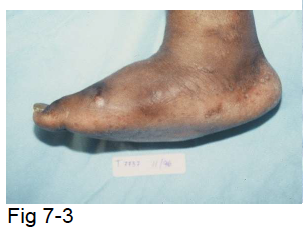Chapter 7 – Charcot Foot in diabetes
Chapter 7 – CHARCOT FOOT IN DIABETES
Charcot's foot, also known as diabetic osteoarthritis, is common in both insulin-dependent and non-insulin-dependent diabetics. This condition is often misdiagnosed and improperly treated, as a red, swollen foot with increased skin temperature is frequently mistaken for an infection. (see Fig. 7-1).
Charcot's foot in diabetics is characterized by a progressive, relatively painless destruction of the bones and joints, particularly in the arch of the foot. The extensive structural damage can make a Charcot foot appear similar to a malignant bone tumor, and its presentation may mimic an acute bone infection. However, laboratory tests and imaging studies such as X-rays or an MRI are essential for establishing an accurate diagnosis. Because patients often do not experience pain despite the significant changes in foot shape, diagnosis and treatment can be delayed until the characteristic deformity becomes pronounced.
The arch of the foot may disappear completely, resulting in a flat foot that bears weight abnormally. This change can lead to a large ulceration under the arch, which further complicates the condition by increasing the risk of bone infection and eventual amputation.
The probable causes of Charcot's diabetic foot are primarily neuropathy and trauma. The autonomic nervous system (see Chapter 2) regulates blood flow to the foot. In autonomic neuropathy, increased blood flow to the bones of the foot can strip away essential materials from the bone, weakening it. As these weakened bones continue to bear the body's weight and endure stress, the bones and joints gradually undergo destruction.
Additionally, sensory neuropathy (see Chapter 2) leads to a loss of pain sensation, so the damage progresses unnoticed. Consequently, the diabetic patient with Charcot's foot may continue walking until the foot becomes severely deformed. Although this destructive process eventually stabilizes and heals, the foot's disfigured shape cannot be restored (see Fig. 7-5).

Prompt podiatric medical attention is essential if you notice gradual swelling, redness, or increased skin temperature on your foot. In such cases, immediately refrain from putting weight on the affected foot by using crutches until your doctor can establish an accurate diagnosis. It is imperative to rule out bone infection, and treatment should include complete non-weight bearing of the affected foot—using crutches, rest, or possibly a CROW boot. Failure to diagnose and treat an infection can lead to devastating consequences, including leg amputation. Non-weight bearing is absolutely required until the inflammation subsides and the destructive phase of the condition is complete.







